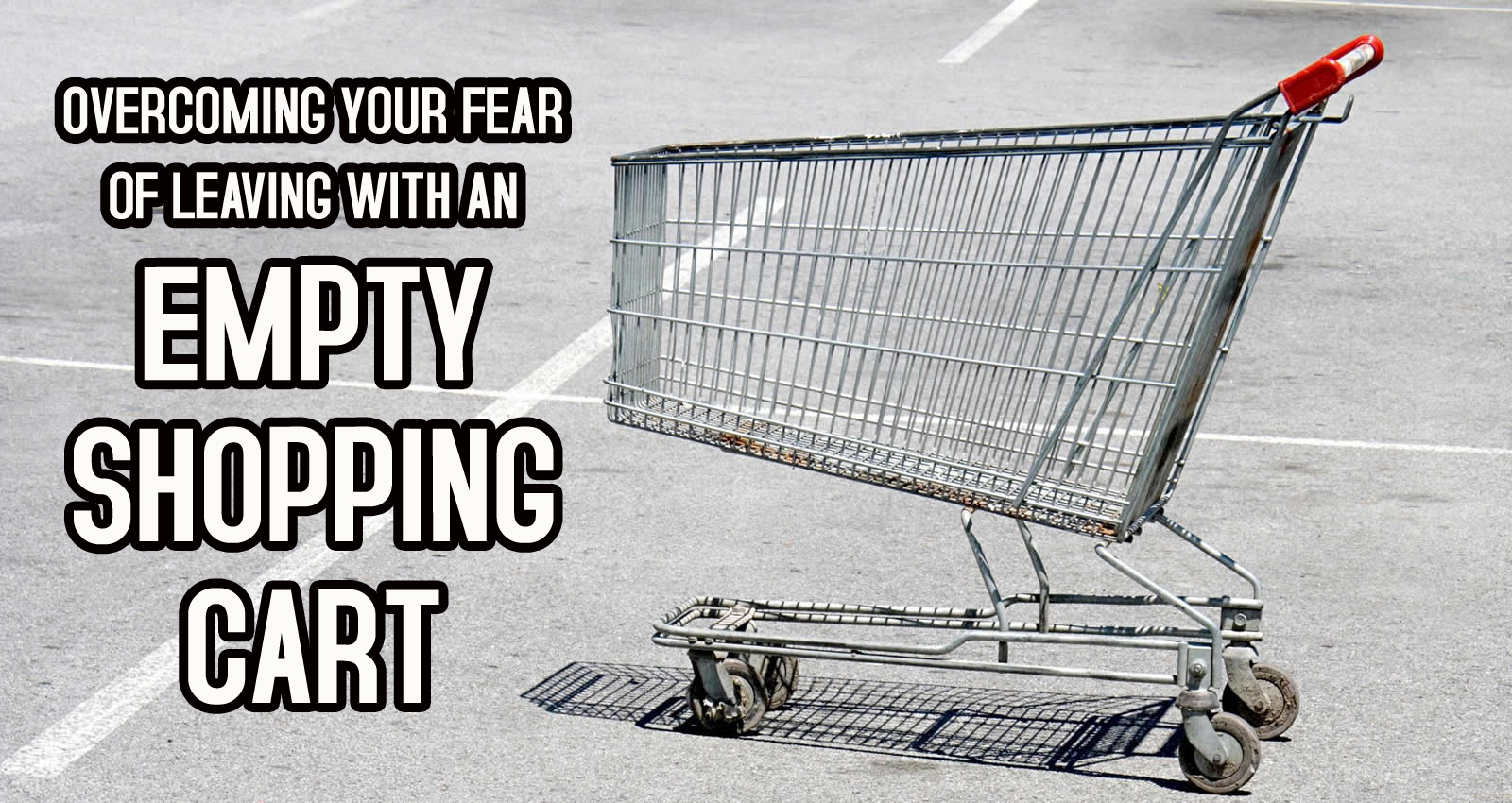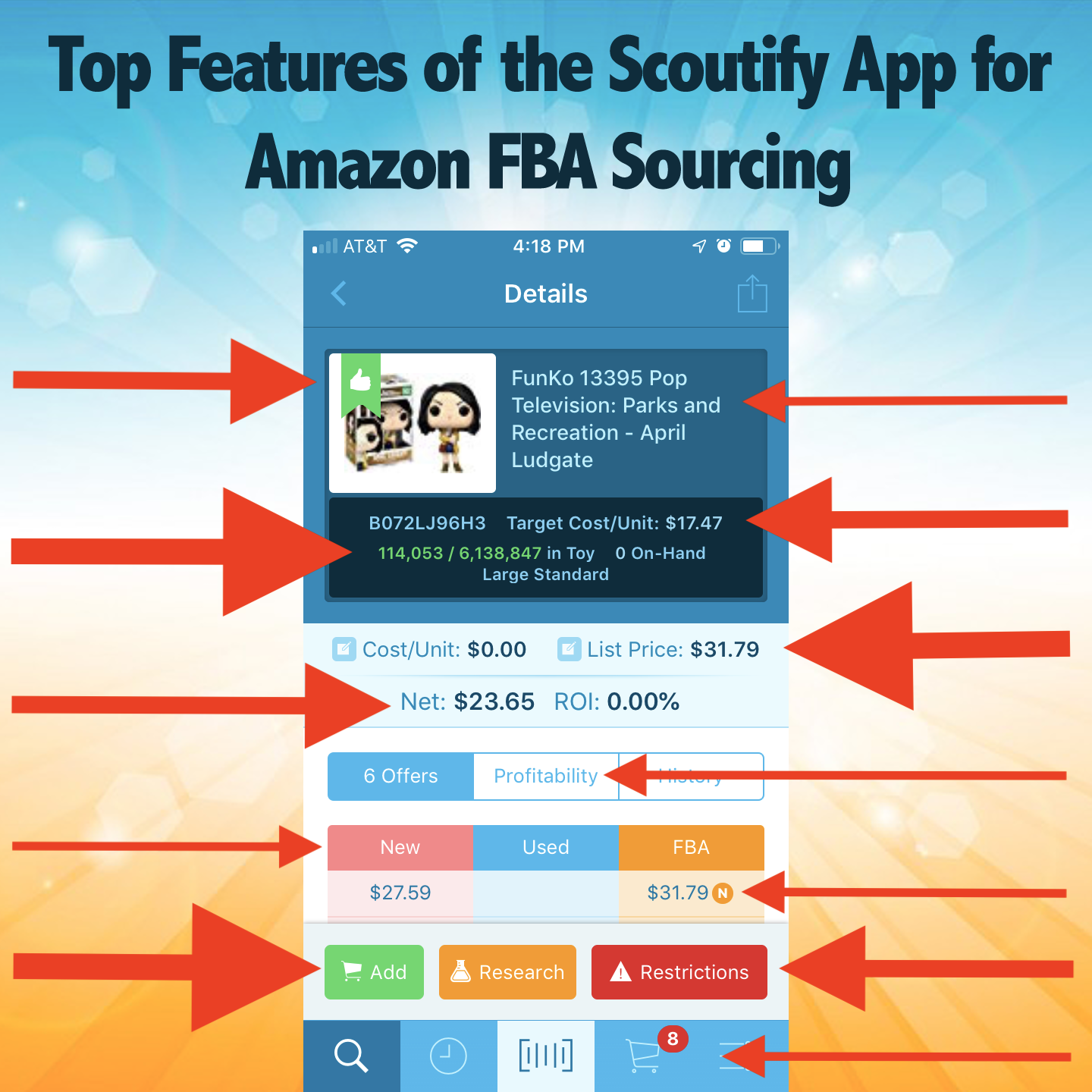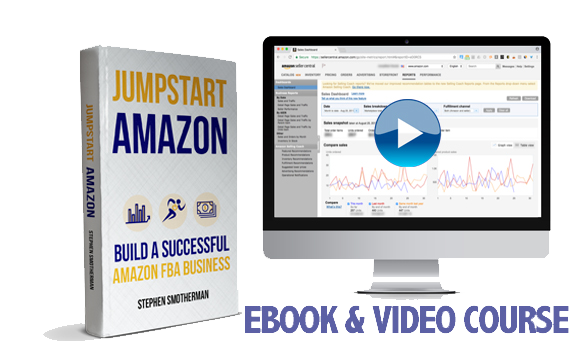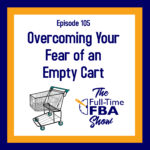Welcome to the second installment of our October Fears Series! This week, we’ll be talking about a fear that many of us are all too familiar with: the fear of leaving a sourcing expedition with an empty cart. It’s easy to think that this fear only applies to physical retail shopping, but it’s actually relevant to any kind of sourcing, whether it’s in person or online.
Today we want to help you overcome the fear of not finding any inventory, because sometimes the only thing worse than leaving with an empty cart is leaving with a cart full of inventory you can’t sell. In our conversation, we break down how fear can stop you from pursuing opportunities, the comparison trap, and how to avoid filling your cart with unprofitable items.
We also share tools and resources that you can use if you’re struggling to find inventory, as well as some helpful questions to help you figure out how you can change your approach. Tune in today to learn more about how to overcome your fear of an empty cart, as well as get a sneak peek into next week’s episode!
Listen on the podcast player below.
Like what you hear? Tell a friend… and be sure to leave us a rating and a review. Here’s how.
Key points from Episode 105:
 Why sellers fear not finding any inventory no matter the sourcing method that they’re using.
Why sellers fear not finding any inventory no matter the sourcing method that they’re using.- How the fear of an empty cart can prevent you from pursuing more opportunities.
- Why not finding inventory to sell can actually be a good thing.
- Leaving with an empty cart and why it’s often better than buying the wrong inventory.
- How to avoid putting unprofitable items in your cart out of fear.
- The comparison trap and how to maintain perspective.
- What to do if you repeatedly struggle to find inventory.
- Some tools and resources to support your sourcing strategies.
- And more!
Links and resources mentioned in this episode:
 Know your Numbers
Know your Numbers- Dealing with Dead Inventory
- Scoutify sourcing app
- InventoryLab
- Keepa – Amazon product price and sales rank tracker
- How to Read & Understand a Keepa Graph
- Tactical Arbitrage – Use code FULLTIME10 for extended trial
- Full-Time FBA courses & ebooks
Right-click here and save as to download this episode to your computer.
 More Episodes from the Full-Time FBA Show podcast:
More Episodes from the Full-Time FBA Show podcast:
Don’t miss an upcoming episode! Subscribe, download episodes, and review the Full-Time FBA Show:
-
-
- Subscribe on iTunes
- Follow on Spotify
- Follow on Amazon Music (or just ask Alexa to “play The Full-Time FBA Show podcast”)
- Follow on iHeartRadio
- Subscribe on Podbean
- Subscribe on Podbay
- Subscribe on Podchaser
-
![]()
 JumpStart Amazon
JumpStart Amazon
Build a Successful Amazon FBA Business
By now you know that running a successful Amazon business takes hard work, but you also want to be sure you spend your time focusing on Amazon FBA strategies that are actually proven to provide the results you’re looking for. If you’re ready to finally get serious about your Amazon FBA business, then I invite you to check out JumpStart Amazon: Build a Successful Amazon FBA Business.
JumpStart Amazon is a combination video course and ebook. The ebook is over 220 pages filled with the content and graphics you need to start a successful Amazon business from scratch. The video course features 5 main sections, 19 content-packed modules, and over 40 videos adding up to over 10 and a half hours of video training. This training is set up to help you build a solid foundation and then know how to find growth and success on top of the basics. This course is packed with more results-focused knowledge than any other ebook out there centered around starting an Amazon business. Find out more about JumpStart Amazon today.
![]()
Back to the main page for The Full-Time FBA Show
![]()
Episode 105 Transcript:
 [INTRODUCTION]
[INTRODUCTION]
[0:00:00.4] STEPHEN: With it being October, we are in the middle of our October Fears series, about how to overcome fears in your Amazon FBA business. Of course, we have some different theme music, so let’s just get that going and get right into the show’s intro.
[0:00:12.5] ANNOUNCER: Welcome to The Full-Time FBA Show. In each episode, it’s our goal to help you turn part-time hours into a full-time income, selling almost anything on Amazon. Now, your hosts of the show, Stephen and Rebecca Smotherman.
[CONVERSATION]
[0:00:31.0] STEPHEN: Welcome to Episode No. 105 of The Full-Time FBA Show. We are excited that you’ve decided to join us today in this episode. Last week, we’ve talked about overcome your fear of going to deep and buying too much. Today, we’re going to talk about the opposite. Overcoming your fear of an empty cart, not finding enough. I mean, that’s the worst feeling in the world, trying to go through a retail store or even an online store not finding anything. To talk about that with me today is Rebecca. How is it going, Rebecca?
[0:00:56.5] REBECCA: Going good.
[0:00:57.6] STEPHEN: Good. I’m glad. We are going to help everyone overcome this fear because man, no one wants to experience this. Spent a lot of time finding an inventory and coming home with nothing. Let’s talk about that on this episode of The Full-Time FBA Show.
[0:01:14.2] REBECCA: Okay. Let’s get right into our topic for the day, how to overcome your fear of an empty cart when you are sourcing for your FBA business. In this topic that we’re talking about can apply no matter what type of sourcing you’re doing. I think a lot of times we think about with an empty cart, we think about physically going into a retail store, and grabbing a cart and walking up and down the aisles, and your cart is empty, and you’re scanning items, you’re looking for items. The cart is empty, you can’t find anything. How long are you going to be in the store before you find something to put in the car? I think that’s a lot of time what we’re thinking about when we say that fear of an empty car. But it can also apply if you are sourcing online, if you’re doing OA, online arbitrage, in an online retailer or if you’re doing wholesale sourcing. If you have found a wholesale supplier that looks like it could have some good inventory, but the more you look and the more you scan the items in their catalog, the more you realize, “Actually, I don’t think there’s anything here.”
We can be afraid of having an empty cart, concerned, worried about, I’m not finding anything from this source no matter what type of sourcing method we’re using. Why would you say, Stephen, as we’re going into this topic a little bit deeper, why would you say that people have this fear of an empty cart? What does that even mean? What are we talking about being afraid of having an empty cart when it comes to sourcing for FBA inventory?
[0:02:34.4] STEPHEN: Like you said, this can be applied to any type of sourcing strategy, but it’s easier for me to kind of imagine the retail cart. Like you said, an actual empty cart that you grab going into the door, you have high expectations and then you’re not able to find something. After a short time, that fear starts to creep in. What if I don’t find anything? What if I am just wasting my time going here? I’m scanning items, I’m not finding anything profitable. I’m not going to have any inventory to sell, because, I mean, that’s the name of the game when it comes to selling on Amazon. You got to have inventory to sell. That fear just starts creeping in and it starts knocking down our confidence levels and makes us sometimes even not even want to go out and source for inventory, because like, what’s the use? I’m not going to be able to find anything. That fear is legit that some people have, but we’ll help you overcome that today.
[0:03:23.6] REBECCA: Yeah. It sounds like to come kind of it comes down to, it’s really a fear of failure in some respects.
[0:03:28.4] STEPHEN: Yes.
[0:03:29.8] REBECCA: That can be big when it comes to running a business.
[0:03:31.4] STEPHEN: Yeah, but the truth it, you know what, if you’re not able to actually find some inventory to sell, that’s probably actually a good thing.
[0:03:38.5] REBECCA: Okay. How is that a good thing? You elaborate on that.
[0:03:41.7] STEPHEN: Right. If you find out that you’re spending a lot of time in a store and you’re not finding anything, it could be because (a) there’s actually not profitable inventory right there, so maybe you need to tweak your strategy or maybe you’re not sourcing the right items, looking at the right items. But it actually could be a lot worse, because buying no inventory is actually better than buying the wrong inventory.
Maybe you have inventory items you’re tempted to purchase because you don’t want to leave with an empty cart, so maybe you kind of go a little bit beyond your parameters when it comes to sourcing. Maybe you buy an item that you think, “Hmm, this usually isn’t something I would buy, but I want something to go home with me today and I need some inventory, so I’m going to buy this as just like a hope and risk and just kind of maybe crossing my fingers that this will sell at a high profit.”
You might end up making a really big mistake by putting money into inventory that’s never going to sell and just click desk on Amazon’s shelves. It could be a lot worse. You can waste money on an inventory that’s not going to sell, waste a lot of time on inventory that’s not going to sell and even spend money on storage fees, and removal order fees and all sorts of stuff on inventory that doesn’t sell. Actually, leaving with an empty cart could be a lot better than buying the wrong inventory.
[0:04:53.4] REBECCA: Yeah. Buying the wrong inventory is the gift that keeps on giving when it comes to –
[0:04:57.3] STEPHEN: You mean taking, right?
[0:04:58.7] REBECCA: Right. You have that money that you’ve wasted on the inventory itself, money on storage fees, dealing with the removals and then you still have the inventory. You still have to figure out if you remove that inventory, what am I going to do with it now? How am I going to deal with this? You’re spending a lot of mental energy trying to deal with it later on, when if you had just made that mental decision at the time of purchase not to purchase it, because it really wasn’t the best fit, you wouldn’t have to deal with all of that later on.
[0:05:25.6] STEPHEN: Yes.
[0:05:26.4] REBECCA: How can a reseller avoid putting those unprofitable items in their cart just so they don’t leave empty handed?
[0:05:33.1] STEPHEN: A few things to be sure to avoid when you are outsourcing. First off, you want to make sure you know your numbers. Make sure you have your parameters, when it comes to sourcing, agreed upon before you actually go out and source. You need to know, what kind of ROI I’m going to be looking for? What kind of average sales do I want to look for, for an item in whichever particular category that you’re sourcing in.
Know your parameters ahead of time and stick to those parameters. You might be tempted to, like I said before, stretch your parameters just to be able to find some things. But no, stick to your guns, stick to what you’ve decided ahead of time and you’re going to be able to come out ahead eventually.
[0:06:11.2] REBECCA: Are there any other factors that you can think of that would cause people to fear the empty cart besides the ones we’ve already covered?
[0:06:17.3] STEPHEN: One thing is the comparison trap. I know a lot of people in some Facebook groups like to post pictures of carts filled with inventory that they’re going to be selling or maybe a receipt as tall as they are of all this inventory. When you see people sharing that on Facebook or any other groups, it begins to kind of creep in, that if they’re able to do that, why can’t I do that. When you make a comparison of your experience versus someone else’s experience is just can really cause you to again, fear that empty cart and maybe cause you to make some bad decisions.
One thing we need to realize is that the people who buy this inventory, filling out carts, who knows if it’s profitable, who knows if it’s really good, who knows if it’s going to sell, who knows if they even purchased it. They might have just put a bunch of stuff in their carts. You want to make sure that if you are trying to compare an average day for you, or maybe even your worst day with someone else’s best day, that’s not healthy. We need to be able to take what we’re doing and maybe only compare it to how we did the last time. We don’t want to compare ourselves to someone else’s best day. We just kind of want to continually try to improve on our own days and stick with our parameters like before. If we leave with an empty cart, it’s okay.
[0:07:29.5] REBECCA: Yeah. I think we’ve mentioned it in many blog posts we’ve posted many times the quote, “Comparison is the thief of joy.” This is definitely, joy and fear do not go together. If you are afraid of an empty cart, you’re going to be comparing yourself to other people and you are not going to have any type of joy in your business. We know that like, we’re doing our business in order to make money, but we should also have fun at it, and enjoy it. It is no way to live life to be going around comparing yourself to somebody else’s business.
[0:08:02.2] STEPHEN: Yes, absolutely.
[0:08:04.4] REBECCA: If this is a problem that keeps happening for you, and I know that we all struggle with this at times, to feeling frustrated that we’re not finding as much as we would want to sell on Amazon. What would you suggest that a seller should do if they keep running into this problem?
[0:08:19.3] STEPHEN: If you keep finding yourself not finding much inventory every time you go out, you have this empty cart experience, then you need to be doing something different. I mean, you need to ask questions to kind of figure out what’s going wrong and try something new to get a new result. Some questions that you can ask, “Do I need a new sourcing strategy?” Maybe you continually had success at Walmart for a while, but now you go to Walmart and you can’t find much. Well, maybe you need to go to a different store or maybe you got started with Amazon and you found some good success in the clearance section and now, the clearance section is not giving you the results that you used to get. Well, what about a regular price aisle in the store? Or maybe you got really into Amazon with a particular category and now that category is kind of dried up and it’s not as good as it used to be. Is there a different category that you can try?
Just ask those kinds of questions. What kind sourcing strategy can you tweak? Because most stores have thousands upon thousands upon thousands of inventory items. A lot of times, we’re not looking at all of them. What kind of other items can we be looking for? That’s a question that you can ask. Another question is, are there any tools that can help me that I’m not using?
Maybe there are tools that help sourcing, help shave time off of your sourcing or give you the information that you need to make a better decision, a tool like when doing retail arbitrage, like Scoutify that gives me almost all the information I need or links to the information I need, like a Keepa graph to make a really good sourcing decision. Or maybe online arbitrage, a tool like Tactical Arbitrage that helps shave a lot of time off your sourcing, and so you’re able to find inventory based on certain parameters that you’re scanning on these online websites. Are there tools out there that you’re not using that you should try using to see if it will help you?
Finally, a question to ask, what can I actually learn to help myself grow? Maybe you’ve gotten in on Amazon and you’ve got some basic understanding, but there’s some things that you need to learn to make better decisions. Maybe there’s like different courses that you can take or maybe there are some YouTube videos that you can watch. We’ve got a whole list of training courses and eBooks that can help you grow in many different areas of your Amazon business. You can go to fulltimefba.com/ourtrainings to see a full list of those. Maybe there’s a certain area of your Amazon business that you need to step up and learn and dedicate yourself to taking your knowledge to the next level of a particular area.
Asking those questions, is there a sourcing strategy tweak I need to have? Are there tools that I can use? Is there anything else I can learn to help me? Then after that you go through that process, then do something different. If you keep doing the same thing, you’re going to keep getting the same results. Do something different so you can get a different outcome.
[0:10:55.9] REBECCA: Yeah. Now, I’d add to that too to what you’re saying. Find some YouTube videos to watch. We do have an entire YouTube channel with hundreds of videos as well that cover a multitude of topics related to sourcing and running an FBA business, so be sure and check out the Full-Time FBA YouTube channel as well.
[0:11:12.3] STEPHEN: Yep, fulltimefba.com/youtube is where you can find that.
[0:11:14.9] REBECCA: We hope that this episode has been helpful in kind of summing up some different ways that you can overcome your fear of an empty cart, and so that you can get out there and you can do your sourcing whether it is out in a retail store or in your office on your computer as you are doing OA or wholesale sourcing.
Either way, we hope that you are able to think through and strategize better ways to approach your sourcing so that you are not afraid of walking away from a potential source and saying, “You know what? That source does not have anything for me to buy right now.” That is okay. I will find inventory somewhere else.
[0:11:47.5] STEPHEN: Absolutely.
[END OF EPISODE]
[0:11:55.2] REBECCA: Thank you, as always, for joining us for this episode of The Full-Time FBA Show. If you would like to see any of the links that were mentioned in this episode or a transcript of the episode, you can find that in show notes at fulltimefba.com/105 because this is Episode No. 105 if The Full-Time FBA Show.
[0:12:13.1] STEPHEN: Next week on the show, we’re continuing our October fear series. We’re going to help you overcome your fear of branching out into new categories. Maybe we talked about earlier about finding a new sourcing strategy. If you’ve been stuck on a certain category that you used to find success in and it’s not as good anymore, well, maybe you need to add more categories. We’re going to help you overcome that fear of branching out into a new category selling on Amazon next week on The Full-Time SBA Show.
[OUTRO]
[0:12:41.0] ANNOUNCER: That is all for this episode of The Full-Time FBA Show. So head over to fulltimefba.com/podcast, where you will find the show notes and links from this episode. While you’re there, subscribe to our newsletter where you’ll get several free downloads of our popular and helpful Amazon FBA resources including a free eBook. Now, take action on what you have learned today so you can find success at turning part-time hours into a full-time income with Amazon FBA.
[END]

Leave a Reply